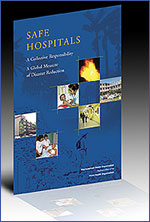 Protecting critical health facilities, particularly hospitals, from the avoidable consequences of disasters, is not only essential to meeting the Millennium Development Goals set by the United Nations, but also a social and political necessity in its own right. This is the message that Safe Hospitals—A Collective Responsibility, A Global Measure of Disaster Reduction, prepared by PAHO/WHO for the UN World Conference on Disaster Reduction, puts forth.
Protecting critical health facilities, particularly hospitals, from the avoidable consequences of disasters, is not only essential to meeting the Millennium Development Goals set by the United Nations, but also a social and political necessity in its own right. This is the message that Safe Hospitals—A Collective Responsibility, A Global Measure of Disaster Reduction, prepared by PAHO/WHO for the UN World Conference on Disaster Reduction, puts forth.
According to the publication, the vulnerability of a hospital is more than a medical issue. Other factors must be taken into account: public health, socio-political significance, and the economic aspects. It is possible to reduce the vulnerability of a hospital by raising the levels of life, investment and operational protection not only in existing facilities, but in the plans for new installations as well. It has been proved time and again that disaster mitigation measures pay off when health facilities are able to withstand the effects of devastating disasters and continue to offer their services. Although the financial investment can be high (and it is not always possible to protect an installation against all kinds of disasters), the cost of ignoring the risks can be much higher, not only in terms of money, but more importantly on the loss of human life.
The importance of hospitals goes far beyond the role they play in saving lives after disasters. They are powerful symbols of social progress and a prerequisite for economic development, and as such, special attention must be given to reducing their physical vulnerability.
The publication can be downloaded from www.paho.org/disasters (select Publications Catalog).
